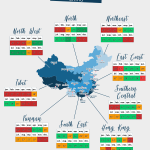Famen Temple (Pinyin: Famensi) is located in Famen town, Fufeng County, 120 kilometer west of Xi’an City, Shaanxi Province. It was widely regarded as the “ancestor of pagoda temples in Guanzhong area”.
History
The founding year of this temple could not be determined even in Tang Dynasty. One speculation is that Famen Temple and the Relic Pagoda were first built when the ancient Indian King Asoka (273 BC – 232 BC) was building 84,000 pagodas. Thus, the pagoda was built even before the temple itself.[citation needed] Before Northern Zhou Dynasty, Famen Temple was called Asoka Temple, and the pagoda was Asoka Pagoda. Another suggestion, supported by unearthed eaves-tiles and carved bricks of Han Dynasty, is that the temple was built during Emperor Huan and Emperor Ling’s years of Eastern Han Dynasty. The literature record indicates that during Northern Wei Dynasty, Famen Temple already had a quite large scale. However, Buddhism was greatly suppressed in Emperor Wu’s years of Northern Zhou Dynasty, and Famen Temple was almost completely destroyed. After establishment of Sui Dynasty, Buddhism was venerated, and Famen Temple was rebuilt, although it couldn’t be recovered to its heydays in Northern Wei Dynasty. Its name was changed to Cheng Shi Dao Chang, and soon it merged with nearby Baochang Temple, and became a temple-owned farm.
After formation of Tang Dynasty, Famen Temple entered its halcyon days. In Wude 1st year(618), Tang Dynasty, it was named Famen Temple, and monks were recruited next year. Later the temple took in homeless people from chaos caused by the war at the end of Sui Dynasty, and was unfortunately burnt. It was rebuilt later by the effort of monks. In Zhenguan 5th year (631), a man named Zhang Liang was appointed to demolish Wangyun Palace to build the pagoda. It was rebuilt in Gaozong Xianqing 5th year(660), and appeared to be a four-storied pavilion-like pagoda. It was named later by Tang Zhongzong “True Relic Pagoda”. Tang Zhongzong actively advocated Buddhism, and along with Empress Wei buried their hairs under the pagoda (unearthed in autumn 1978). Jinglong 4th year (710), the temple was renamed “Grand Empire Carefree King Temple”, and the pagoda “Grand True Relic Pagoda”. In Wenzong Kaicheng 3rd year (AD 838), it was renamed “Fayun Temple”, but soon was changed back to Famen Temple. When Buddhism was suppressed in Huichang year of Wuzong, Famen Temple was affected. In Yizong’s years, it held the last activity of Buddha relic acquisition in Tang Dynasty. At that time, Famen Temple was rebuilt, and its underground palace has never been altered since then. The emperors of Tang Dynasty acquired Buddha relic 7 times here, and every time donated generously, which facilitated the expansion of the temple and pagoda. After being built and renovated multiple times, Famen Temple evolved into a scale of 24 courtyards.
During Five Empires period, the king of Qin, Li Maozhen spent more than 30 years greatly renovating Famen Temple. In Houzhou Zhizong’s year, Buddhism was restricted, but Famen Temple was not abandoned. After establishment of North Song Dynasty, Famen Temple was revived again. After being renovated many times, in Da’an 2nd year, Jin Dynasty, it was claimed to be “Temple and Pagoda against Heaven”. During Longqing’s years (1567-1572), Ming Dynasty, Famen Temple was greatly destroyed in Guanzhong earthquake, and the wood pagoda built in Tang Dynasty collapsed. In Wanli 7th year (1579), the “True Relic Pagoda” was rebuilt, and became 13-storied brick-mimic-timber structured pavilion-like pagoda.
During Qing Dynasty, Famen Temple was renovated in Shunzhi 12th year (1655), Qianlong 34th year (1769), and Guangxu 10th year (1884). In Tongzhi 1st year (1862), the temple was damaged in Huimin Uprising in Shaanxi Province. It’s rebuilt later, but scale shrank a lot. After formation of the Republic of China, Famen Temple was used to station army continuously, and it was largely ruined. Because of natural and man-made calamities and the masses living in dire poverty, North China Philanthropy Association decided to rebuild the temple and pagoda, and use labor work as methods to relieve the distress. The reconstruction started in 1938, and concluded in July 1940. A month later, the Buddhist activities were restored.
After the establishment of the People’s Republic of China, Famen Temple was among the first key protected historical relics of the province. However, the properties of the temple were still appropriated for public uses, such like schools in Famen town. During Cultural Revolution, the Red Guard damaged temple halls and Buddhist figures under the name of “breaking four old fashions”. The abbot, Liangqing monk, incinerated himself in front of the True Relic Pagoda, in order to protect temple’s underground palace. When the palace was unearthed later, the relic of self-immolation could still be seen. Other monks were either demobilized or killed. The temple became “the temporary headquarter of proletariat rebellion of Fufeng County”. After 1979, Shaanxi province government once funded reconstruction of the Grand Hall of the Great Sage and the Brass Buddha Pavilion. At 1:57am of 4 August 1981, half side wall of True Relic Pagoda collapsed in the heavy rain. This incident drew universal attention. In 1984, the government implemented religious policy and handed Famen Temple to Buddhist community. In 1985, Shaanxi province government decided to pull down the remaining half side wall and rebuild the True Relic Pagoda. On 3 April 1987, the underground palace of True Relic Pagoda in Famen Temple was opened, and a large quantities of precious historical relics were unearthed. This was quite a hit in news at that time. The expansion of the temple and the reconstruction of the pagoda were completed in October 1988. On 9 November of the same year, the Famen Temple Museum was opened.
Architecture
Famen Temple currently maintains such a layout as Grand Hall following Pagoda. The True Relic Pagoda is regarded as the middle axle of the temple. Before it stand the Front Gate, the Front Hall, and behind it is the Grand Hall of Great Sage. This is the typical layout of the early Buddhist temples in China.
The True Relic Pagoda has been altered several times. It evolved from four-storied pavilion-like pagoda in Tang Dynasty to thirteen-storied brick pagoda in Ming Dynasty. The current version was rebuilt based on the surveyed drawing of the pagoda in Ming Dynasty before it collapsed. It is made of armored concrete as skeleton, and then covered by grey bricks. Inside the pagoda there are sightseeing platforms for tourists.
The underground palace was restored to the structure of Tang Dynasty. Only few severely damaged parts were replaced. The whole palace was built by white marbles and limestone tablets. Inner walls and stony gate are all engraved. During the renovation of the underground palace, a circular basement was built surrounding the Tang palace, and Buddhist shrines were included. The preserved Buddhist finger relic rests at the center of the underground palace.
The western division of the temple is Famen Temple Museum, including multi-functioning reception hall, treasure hall and other buildings.
Relics
Buddha’s relics
From 5-12 May 1987, four Buddha’s relics were found after the opening of underground palace. Two of them were made of white jade. The third one was from a famed monk. These three are called “ghost relics”. They were placed together with “true relic” in order to protect the latter. The true relic appeared to be yellow-colored, with bone-like secretory granules. It was identified by experts to be true Buddha relic. Thereafter, Famen Temple became Buddhist resort due to the discovery of true Buddha’s relic.
Gold & Silver Apparatus
Colored Glaze
Colored Glaze is just today’s glass. Chinese glass manufacturing technology was long influenced by western Asia, and most common style was Islamic. Because of it rarity, glass apparatus was as valuable as gold and jade. The unearthed glass apparatuses are mostly hollowware such as disks, plates and bowls, totally over 20 pieces.
Ceramics
There were a lot of speculations of “Mystic Color Ceramics” prior to the opening of underground palace. Someone thought mystic color referred to a secret craft of glazing color. Others believed it was a name for a specific color. This conundrum was solved by the description on the accounting tablet in the underground palace, and by the unearthing of 13 precious pieces of mystic color ceramics.
Silk
China’s silk industry reached its prime time in Tang Dynasty, and the silk fabrics discovered in underground palace provided a convincing evidence. Most of those fabrics were contributed by former Empresses. Among them there is a “Empress Wu’s Embroidered Skirt” belonging to Wu Zetian.
Buddhist scriptures
Figure of Buddha
There were 88 niches of Buddha in the 13-storied pagoda in Ming Dynasty, each containing a figure. By 1939, there were only 68 left. Later after clear-up, there were totally 98 figures of Buddha, many containing scriptures, sealed at the times of Ming Dynasty and the Republic of China.























 Online | Privacy policy
Online | Privacy policy